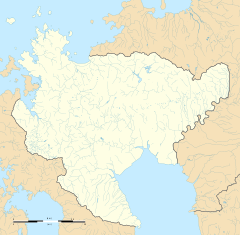Higashi-Taku Station
33°17′07″N 130°08′37″E / 33.2853°N 130.1435°E / 33.2853; 130.1435
 JR Kyushu
JR Kyushu| Preceding station |  JR Kyushu JR Kyushu | Following station | ||
|---|---|---|---|---|
| Ogi towards Kubota | Karatsu Line | Naka-Taku towards Nishi-Karatsu | ||
Location | |
|---|---|
  Higashi-Taku Station Location within Saga Prefecture Show map of Saga Prefecture  Higashi-Taku Station Higashi-Taku Station (Japan) Show map of Japan | |
 |
Higashi-Taku Station (東多久駅, Higashi-Taku-eki) is a passenger railway station on the Karatsu Line operated by JR Kyushu located in the city of Taku, Saga Prefecture, Japan.[1][2]
Lines
The station is served by the Karatsu Line and is located 10.6 km from the starting point of the line at Kubota.[3]
Station layout
The station, which is unstaffed, consists of two opposed unnumbered side platforms serving two tracks. Access to the opposite side platform is by means of a footbridge. A waiting room and toilet building has been built near the footbridge. A siding branches off track 2.[2][3]
Platforms
| south side | ■ JK Karatsu Line | for Karatsu and Nishi-Karatsu |
| north side | ■ JK Karatsu Line | for Saga |
-
 View of the platforms and tracks.
View of the platforms and tracks.
History
The Karatsu Kogyo Railway had opened a track from Miyoken (now Nishi-Karatsu) which, by 25 December 1899, had reached Azamibaru (now Taku). On 23 February 1902, the company, now renamed the Karatsu Railway, merged with the Kyushu Railway which undertook the next phase of expansion. The track was extended east, with Kubota opening as the final eastern terminus on 14 December 1903. Higashi-Taku (then named Befu Station (別府駅)) opened on the same day as an intermediate station on the track. When the Kyushu Railway was nationalized on 1 July 1907, Japanese Government Railways (JGR) took over control of the station. On 12 October 1909, the line which served the station was designated the Karatsu Line. On 1 June 1911, the station was renamed Higashi-Taku. With the privatization of Japanese National Railways (JNR), the successor of JGR, on 1 April 1987, control of the station passed to JR Kyushu.[4][5]
Passenger statistics
In fiscal 2016, the daily average number of passengers using the station (boarding passengers only) was above 100 and below 323. The station did not rank among the top 300 busiest stations of JR Kyushu.[6]
Surrounding area
- Japan National Route 203
- Higashi-Taku Post office
- Nagasaki Expressway
See also
References
- ^ "JR Kyushu Route Map" (PDF). JR Kyushu. Retrieved 3 March 2018.
- ^ a b "東多久" [Higashi-Taku]. hacchi-no-he.net. Retrieved 12 March 2018.
- ^ a b Kawashima, Ryōzō (2013). 図説: 日本の鉄道 四国・九州ライン 全線・全駅・全配線・第5巻 長崎 佐賀 エリア [Japan Railways Illustrated. Shikoku and Kyushu. All lines, all stations, all track layouts. Volume 5 Nagasaki Saga area] (in Japanese). Kodansha. pp. 18, 81. ISBN 9784062951647.
- ^ Ishino, Tetsu; et al., eds. (1998). 停車場変遷大事典 国鉄・JR編 [Station Transition Directory – JNR/JR] (in Japanese). Vol. I. Tokyo: JTB Corporation. pp. 223–4. ISBN 4-533-02980-9.
- ^ Ishino, Tetsu; et al., eds. (1998). 停車場変遷大事典 国鉄・JR編 [Station Transition Directory – JNR/JR] (in Japanese). Vol. II. Tokyo: JTB Corporation. p. 719. ISBN 4-533-02980-9.
- ^ "駅別乗車人員上位300駅(平成28年度)" [Passengers embarking by station - Top 300 stations (Fiscal 2016)] (PDF). JR Kyushu. 31 July 2017. Archived from the original (PDF) on 1 August 2017. Retrieved 3 March 2018.
External links
 Media related to Higashi-Taku Station at Wikimedia Commons
Media related to Higashi-Taku Station at Wikimedia Commons
- Higashi-Taku Station (JR Kyushu)(in Japanese)
 | This Saga Prefecture railroad station-related article is a stub. You can help Wikipedia by expanding it. |
- v
- t
- e












